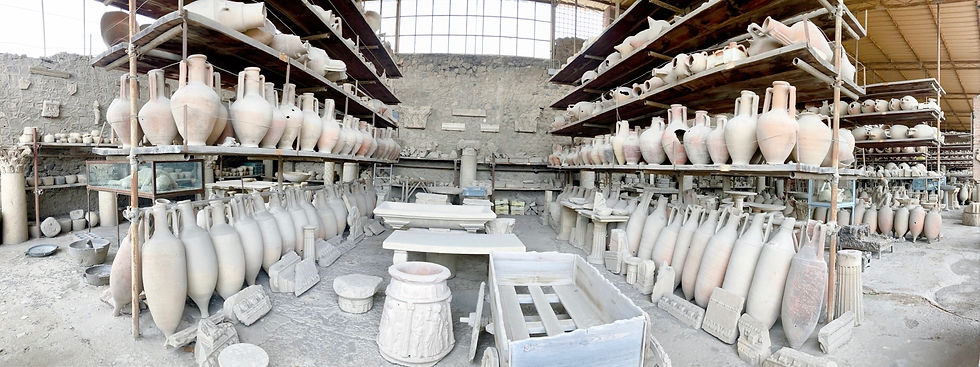Day 39 - Field Trip to Pompeii
- Sarah Fink

- Oct 14, 2020
- 2 min read
My elementary-school self dreamed of being an archeologist and owning a Hallmark shop. Yes, even back then, I realized this might logistically be hard to juggle!
Today, I came close to fulfilling one of those dreams... well almost... by exploring Pompeii—an ancient site I've always longed to see! Our whole family learned so much about this Roman city and found it fascinating as we walked around for hours.

I geeked out seeing all of these artifacts!
Pompeii was way more sophisticated and extensive than I imagined it to be all these years. Technology like hot running water and advanced traffic systems, including one-way streets, sidewalks and crosswalks, surprised us. The place was dotted with colorful frescos, artisan shops, gyms, spas, theatres and even several corner wine bars! I could see the allure of living in this innovative, fertile city back in its day. Being nestled in the foothills of misty emerald green mountains reminded me of our hometown, Issaquah.

Clint and the kids were most intrigued by Pompeii's amphitheater—the world's oldest remaining Roman amphitheater, which held 20,000 spectators in its glory. They enthusiastically reenacted gladiator battle after gladiator battle until inevitably someone always ended up getting upset but then yearned for more. I would just zone out and pretend I had my trowel and brush in hand, unearthing intricately carved bone hairpins and clay pots!

When Mt. Vesuvius blew its top in 79 AD, Pompeii was buried under twenty feet of hot ash. The story of Pompeii's demise became even more tragic after discovering that the word "volcano" wasn't even in its citizens' vocabulary. The people of Pompeii had no idea what Mt. Vesuvius was capable of. The once-thriving city lain in a Sleeping Beauty-esque sleep until it was rediscovered in the 18th century.
DIGGING DEEPER: What's the difference between Pompei and Pompeii?
Pompei - A modern city near the city of Naples that contains the ruins of Pompeii.
Pompeii- The ancient city of Roman now in ruins.
During the first phase in the mid-1700s, the excavation's sole purpose was to find suitable art objects for King Charles III's private collection. The pieces were transported to Naples, where they remain to this day, displayed in the National Archaeological Museum. After stripping the ancient city of its prized treasures, the buildings were then back-filled with dirt! During the French control of Naples in the early 1800s, the excavation tactics changed and excavating became more careful, organized and systematic.
Today, about 70% of Pompeii's ruins have been uncovered, but they are slowly deteriorating by exposure to weather, pollution and people. It is unanimously agreed that the rest should be left under the volcanic debris to preserve this important part of our past for future generations.




Even whole loaves of bread were preserved in the ash!!





It was so interesting to learn about their advanced civilization. We've watched several videos about Pompeii and I keep researching it for I find the story so intriguing.
Your opening sentence cracked me up! Ahh, the wonders of youth! We were absolutely amazed at Pompeii and could’ve stayed there for days! It was astonishing to see with my own eyes how advanced these 1st Century citizens were with their incredible inventions and colored frescos. And here we 20th Century inhabitants think we are so inventive and smart!! What a treasure to have uncovered. Thanks for sharing this history lesson. Glad you enjoyed it as much as we did :=)
Sarah, Amazing the lesson you shared on today’s post. Thank you 🙏. Your photos are beautiful!